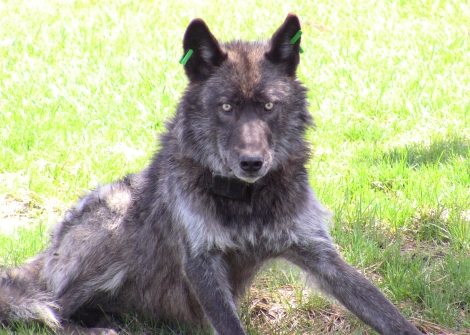Alpha Male (father) Imnaha Pack (Ear tagged and collared May 2011)
FROM: NE OREGON ECOSYSTEMS
More wolves to be killed, and extermination of the entire Imnaha pack is on the table.
ODFW announced yesterday that more Imnaha wolves may be killed, and Oregon conservationists share growing alarm that the entire pack may be exterminated. ODFW Regional Manager Craig Ely implied last month in a conversation with NE Oregon Ecosystems that this option might be on the table, and information from sources close to the ODFW have reinforced this conviction. As it is, the pack has been reduced from 16 members to 8 or less, and 3 wolves have been killed by ODFW this year. One has dispersed to Washington, one collared wolf has disappeared, the whereabouts of some others are unknown. The Imnaha pack is in real trouble…
The ODFW is under crushing pressure from Oregon cattlemen to kill wolves, and unless wolf supporters make their opinions known soon, this pack, Oregon’s first and biggest, its best chance of wolf recovery, will be killed. The opinions carrying the greatest weight will be those from NE Oregon residents. Our legislators, the governor, the ODFW, and the press need to hear from us, not just from the Oregon Cattlemen’s Assoc. and their friends.
Some points to consider:
The Imnaha pack represents half of Oregon’s wolves and the best chance for wolves to disperse to safer habitat in Central and Western Oregon, where livestock conflict is less likely.
Oregon wolves are protected by the Oregon Endangered Species Act. The Oregon Wolf Plan, implemented in 2005 and revised in 2010, requires wolves to be managed for recovery until their numbers allow them to be delisted. Treating every depredation as a crisis to be solved by lethal removals is not a satisfactory management plan for recovering a population. Killing wolves should be only a last resort.
There will always be stock losses from wolves, just as there are from coyote, bear, dog, cougar, eagle,and others. The OWP is not designed to eliminate wolf depredation, any more than state policy is to eliminate losses from any other predator. Predators are part of the livestock business in the West, where huge tracts of public land rightfully provide a home for wildlife, and from which the ranchers benefit by grazing allotments. Despite the presence of the Imnaha pack, no rancher has gone out of business or is in danger of doing so from wolves.
Confirmed wolf depredations are compensated at full market value and probables reimbursed at half market value by Defenders of Wildlife. Vet bills for confirmed wolf-caused injuries are fully compensated. A compensation bill is under consideration by the state legislature.
“The state Endangered Species Act prohibits the killing of listed species with very limited exceptions,” points out Jennifer Schwartz of Hells Canyon Preservation Council, “If ODFW is going to lawfully operate within that narrow window of exceptions, it must be able to show that lethally removing wolves in response to conflicts with livestock is somehow necessary to further their conservation in Oregon. With so few wolves in the state, we are very much unconvinced that we need to kill more wolves in order to promote their recovery.”
After a strong start last year, wolf tourism is just starting to take off this season, with eco-tours scheduled for this summer and private operators planning for 2012. Tourists are planning trips specifically to be in wolf country and Wallowa County will benefit. Obviously the slaughter of the county’s most famous and accessible pack will bring this to a halt, and may well give the county a bad odor to those planning a visit to view wildlife.
Oregon Wild, in a statement on Monday, listed these four ODFW shortcomings:
Violating the wolf plan by baiting members of the Imnaha Pack back to the site of reported depredations leading to more losses that may in turn be used to justify lethal control.
Failure to adequately document and publicly share information on claimed non-lethal preventative measures.
Issuing 24 landowner kill permits without adequately documenting and publicly sharing information demonstrating those permits were issued in compliance with the wolf plan.
Treating every conflict between wolves and the livestock industry as a crisis by devoting nearly all of the agency’s wolf-related time and resources on a small fraction of the duties prescribed by the plan at the expense of research, education, and conservation.
A note on incremental lethal removal:
The management policy being applied this spring by ODFW is called incremental removal and is used when stock predation becomes chronic. It should only be employed after all non-lethal tools have been used. It’s intended to spare the pack while removing the depredating wolves. In the case of the Imnaha pack, it may be a valid policy, but it’s not clear that all the stockmen suffering losses have in fact used all the non-lethal methods, especially removing dead calves from pastures. Dead animals left lying around draw predators, and scavenged carcasses can be presented as wolf kills.
The ODFW is following a protocol designed to save the Imnaha pack, but the pack may also be drawn to prey on cattle by carcasses left on the range.
Please contact the following to express your respectful opinion about lethal removal of the Imnaha pack.
Governor John Kitzhaber: gov.kitzhaber@state.or.us – 503-378-4582.
CC the following:
ODFW Director Roy Elicker: roy.elicker@state.or.us – 503-947-6044.
ODFW Commissioners: odfw.commission@state.or.us (Individual Commissioners here).
Please adapt your letter as a Letter to the Editor (300 word max) and send to
The Oregonian: letters@oregonian.com and post to http://www.oregonlive.com/opinion/
The Chieftain: editor@wallowa.com
The La Grande Observer: tkramer@lagrandeobserver.com
The Baker City Herald: kborgen@bakercityherald.com
Thank you all,
NE Oregon Ecosystems
Imnaha Alpha male (father) August 2009
=======
Photos : Courtesy ODFW



No comments:
Post a Comment